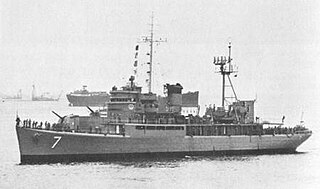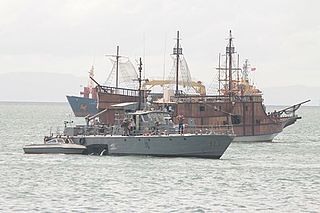
The third USS Casco (AVP-12) was a United States Navy Barnegat-class small seaplane tender in commission from 1941 to 1947. She saw service in World War II. After her decommissioning, the U.S. Navy loaned her to the United States Coast Guard, in which she served as the cutter USCGC Casco (WAVP-370), later WHEC-370, from 1949 to 1969.

USS Yakutat (AVP-32) was a United States Navy Barnegat-class small seaplane tender in commission from 1944 to 1946. Yakutat tended seaplanes in combat areas in the Pacific during the latter stages of World War II. After the war, she was in commission in the United States Coast Guard from 1948 to 1971 as the Coast Guard cutter USCGC Yakutat (WAVP-380), later WHEC-380, seeing service in the Vietnam War during her Coast Guard career. Transferred to South Vietnam in 1971, she was commissioned into the Republic of Vietnam Navy as the frigate RVNS Trần Nhật Duật (HQ-03). When South Vietnam collapsed in 1975 at the end of the Vietnam War, she fled to the Philippines, where the Philippine Navy took custody of her and cannibalized her for spare parts until discarding her in 1982.

USS Bering Strait (AVP-34) was a United States Navy Barnegat-class small seaplane tender in commission from 1944 to 1946. She tended seaplanes during World War II in the Pacific in combat areas and earned three battle stars by war's end.

USS Cook Inlet (AVP-36) was a United States Navy Barnegat-class small seaplane tender in commission from 1944 to 1946. She tended seaplanes during World War II in the Pacific and earned one battle star for her service. After the war, she was transferred to the United States Coast Guard, and was in commission as the Coast Guard cutter USCGC Cook Inlet (WAVP-384), later WHEC-384, from 1949 to 1971. She saw service in the Vietnam War during her Coast Guard career, receiving two campaign stars for her operations during the conflict. Transferred to South Vietnam in 1971, she operated as the Republic of Vietnam Navy frigate RVNS Trần Quốc Toản (HQ-06) until South Vietnam's collapse in April 1975 at the end of the Vietnam War. She fled to the Philippines and in 1976 was transferred to the Philippine Navy, which never commissioned her, instead using her as a source of spare parts for her sister ships, the Andrés Bonifacio-class frigates, before discarding her in 1982.

The BRP Rizal (PS-74) was the lead ship and first of two Rizal class ships in service with the Philippine Navy. She was an ex-USN Auk class minesweeper that was produced during World War II, and was classified as a patrol corvette protecting the vast waters of the Philippines. Along with other ex-World War II veteran ships of the Philippine Navy, she was considered one of the oldest active fighting ships in the world, until 2020.

BRP Sultan Kudarat (PS-22) was a Miguel Malvar-class corvette of the Philippine Navy. It was originally built as USS PCE-881, a PCE-842-class patrol craft for the United States Navy during World War II. In 1961 it was transferred to South Vietnam for service in the Republic of Vietnam Navy as RVNS Đống Đa II (HQ-07). It was acquired by the Philippine Navy on April 1976, and was commissioned later on as RPS Sultan Kudarat (PS-22). Along with other World War II-era ships of the Philippine Navy, Sultan Kudarat was considered one of the oldest active fighting ships in the world, until its retirement in July 5, 2019.

BRP Andrés Bonifacio (PF-7) was a Philippine Navy frigate in commission from 1976 to 1985. She was one of six ex-United States Navy Barnegat-class small seaplane tenders/ex-United States Coast Guard Casco-class high endurance cutters received from the United States after the Vietnam War, two of which were acquired to supply spare parts for the other four. Andrés Bonifacio was considered the lead ship of her class in the Philippine Navy, and she and her three commissioned sister ships were the largest Philippine Navy combat ships of their time.

USS Chincoteague (AVP-24) was a United States Navy seaplane tender in commission from 1943 to 1946 that saw service in the Pacific during World War II. After the war, she was in commission in the United States Coast Guard as the cutter USCGC Chincoteague (WAVP-375), later WHEC-375, from 1949 to 1972. She was transferred to South Vietnam in 1972 and was commissioned into service with the Republic of Vietnam Navy as the frigate RVNS Lý Thường Kiệt (HQ-16), seeing combat in the Battle of the Paracel Islands in 1974. When South Vietnam collapsed at the conclusion of the Vietnam War in 1975, she fled to the Philippines, where she was commissioned into the Philippine Navy, serving as the frigate RPSAndrés Bonifacio (PF-7) from 1976 to 1985.
BRP Diego Silang (PF-9) was an Andrés Bonifacio-class frigate of the Philippine Navy in commission from 1976 to 1990. She and her three sister ships were the largest Philippine Navy ships of their time.
The BRP Francisco Dagohoy (PF-10) was an Andrés Bonifacio-class frigate of the Philippine Navy that served from 1979 to 1985. She was one of six ex-United States Navy Barnegat-class small seaplane tenders and ex-United States Coast Guard Casco-class high endurance cutters received from the United States after the Vietnam War, two of which were cannibalized for spare parts without entering service. She and her other three sister ships were the largest Philippine Navy ships of their time.
The BRP Gregorio del Pilar (PF-8) was an Andrés Bonifacio-class frigate of the Philippine Navy in commission from 1977 to 1990. She was one of six ex-United States Navy Barnegat-class seaplane tenders/ex-United States Coast Guard Casco-class high endurance cutters received from the United States after the Vietnam War, two of which were acquired to supply spare parts for the other four. She and her three commissioned sister ships were the largest Philippine Navy combat ships of their time.

USS Castle Rock (AVP-35) was a United States Navy Barnegat-class small seaplane tender in commission from 1944 to 1946 which saw service in the late months of World War II. After the war, she was in commission in the United States Coast Guard as the Coast Guard cutter USCGC Castle Rock (WAVP-383), later WHEC-383, from 1948 to 1971, seeing service in the Vietnam War during her Coast Guard career. Transferred to South Vietnam in 1971, she served in the Republic of Vietnam Navy as the frigate RVNS Trần Bình Trọng (HQ-05) and fought in the Battle of the Paracel Islands in 1974. When South Vietnam collapsed at the end of the Vietnam War in 1975, Trần Bình Trọng fled to the Philippines, where she served in the Philippine Navy from 1979 to 1985 as the frigate RPSFrancisco Dagohoy (PF-10).

USS Wachapreague (AGP-8) was a motor torpedo boat tender in commission in the United States Navy from 1944 to 1946, seeing service in the latter part of World War II. After her Navy decommissioning, she was in commission in the United States Coast Guard from 1946 to 1972 as the cutter USCGC McCulloch (WAVP-386), later WHEC-386, the fourth ship of the U.S. Coast Guard or its predecessor, the United States Revenue Cutter Service, to bear the name. In 1972 she was transferred to South Vietnam and served in the Republic of Vietnam Navy as the frigate RVNS Ngô Quyền (HQ-17). Upon the collapse of South Vietnam at the end of the Vietnam War in 1975, she fled to the Philippines, and she served in the Philippine Navy from 1977 to 1985 as the frigate RPSGregorio del Pilar (PF-8) and from 1987 to 1990 as BRP Gregorio del Pilar (PF-12).

The Barnegat class was a large class of United States Navy small seaplane tenders (AVP) built during World War II. Thirty were completed as seaplane tenders, four as motor torpedo boat tenders, and one as a catapult training ship.

The Casco class was a large class of United States Coast Guard cutters in commission from the late 1940s through the late 1980s. They saw service as weather reporting ships in the Atlantic and Pacific Oceans until the early 1970s, and some saw combat service during the Vietnam War.

The BRP Carlos Albert (PC-375) is the fifth ship of the Jose Andrada class coastal patrol boats of the Philippine Navy. It is part of the first batch of its class ordered through US Foreign Military Sales (FMS) in 1990, and was commissioned with the Philippine Navy in January 1992. It was initially designated as Fast Patrol Craft, and was numbered "DF-375", but later on was re-designated as a Patrol Gunboat, and was re-numbered as "PG-375", until another round of reclassification changed its designation as a Patrol Craft with hull number "PC-375" from April 2016.

The Del Pilar-class are offshore patrol vessels currently in service with the Philippine Navy and previously in service with the US Coast Guard as Hamilton-class high endurance cutters. The Department of National Defense is currently in the process of upgrading their systems and capabilities under a modernization project awarded to Hanwha Systems of South Korea.

BRP Gregorio del Pilar (PS-15) is the lead ship of her class of offshore patrol vessel of the Philippine Navy. She is the second ship to be named after Gregorio del Pilar, a Filipino revolutionary general known for his role at the Battle of Tirad Pass. She was originally designated as "PF-15" from 2012 to mid-2016. Then the Navy adopted a new code designation system and she was redesignated as "FF-15". In February 2019, the Navy downgraded the status of the entire class from frigate to patrol ship and redesignated her to "PS-15".

BRP Ramon Alcaraz (PS-16) is the second ship of the Gregorio del Pilar-class patrol ships of the Philippine Navy. From 1968 to 2012, she was known as USCGC Dallas and served the United States Coast Guard as a high endurance cutter. She was decommissioned on 30 March 2012 and acquired by the Philippines under the Excess Defense Articles and the Foreign Assistance Act.

BRP Andrés Bonifacio (PS-17) is the third ship of the Gregorio del Pilar-class offshore patrol vessels of the Philippine Navy. She is the second ship of the Philippine Navy to be named after Andrés Bonifacio, a Filipino revolutionary leader, regarded as the "Father of the Philippine Revolution" and one of the most influential national heroes of the Philippines.



















